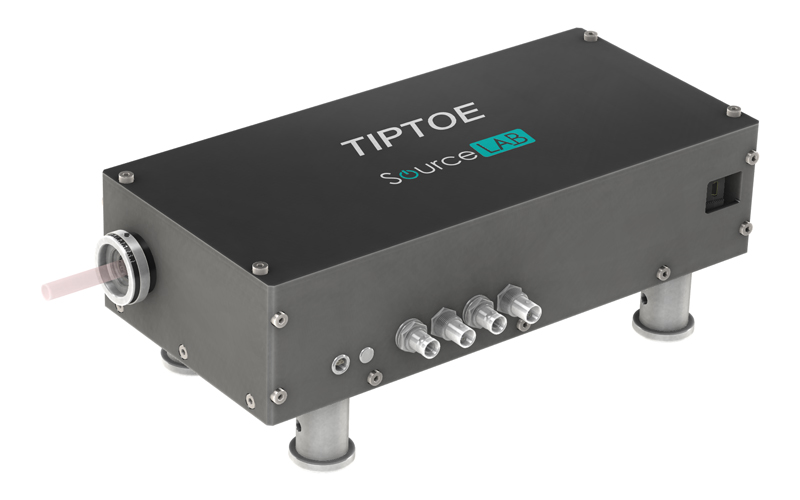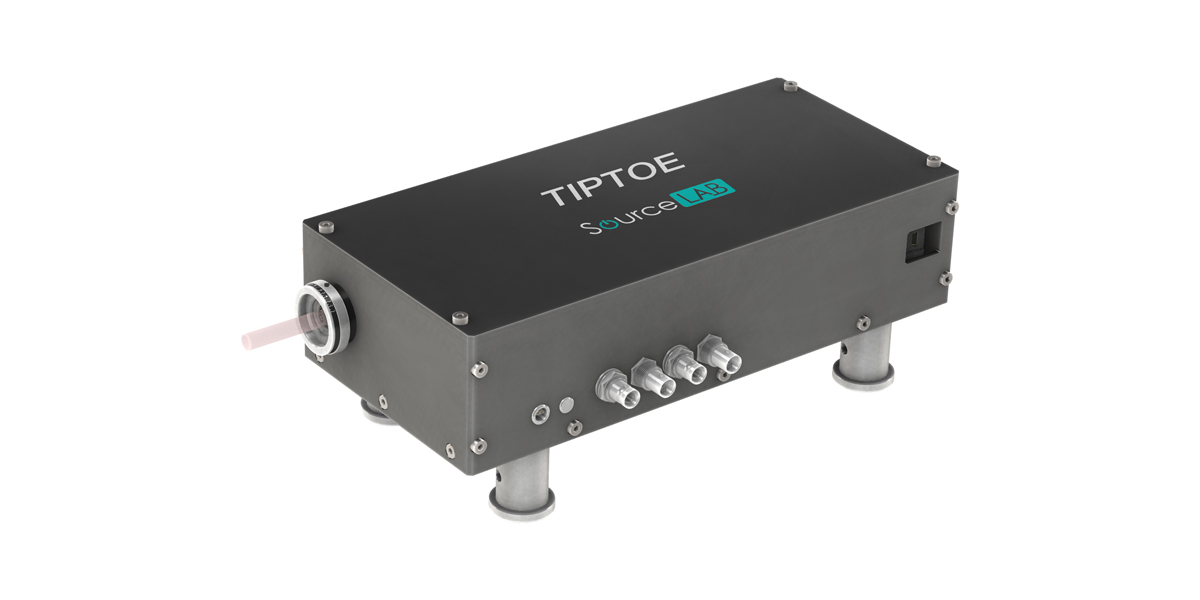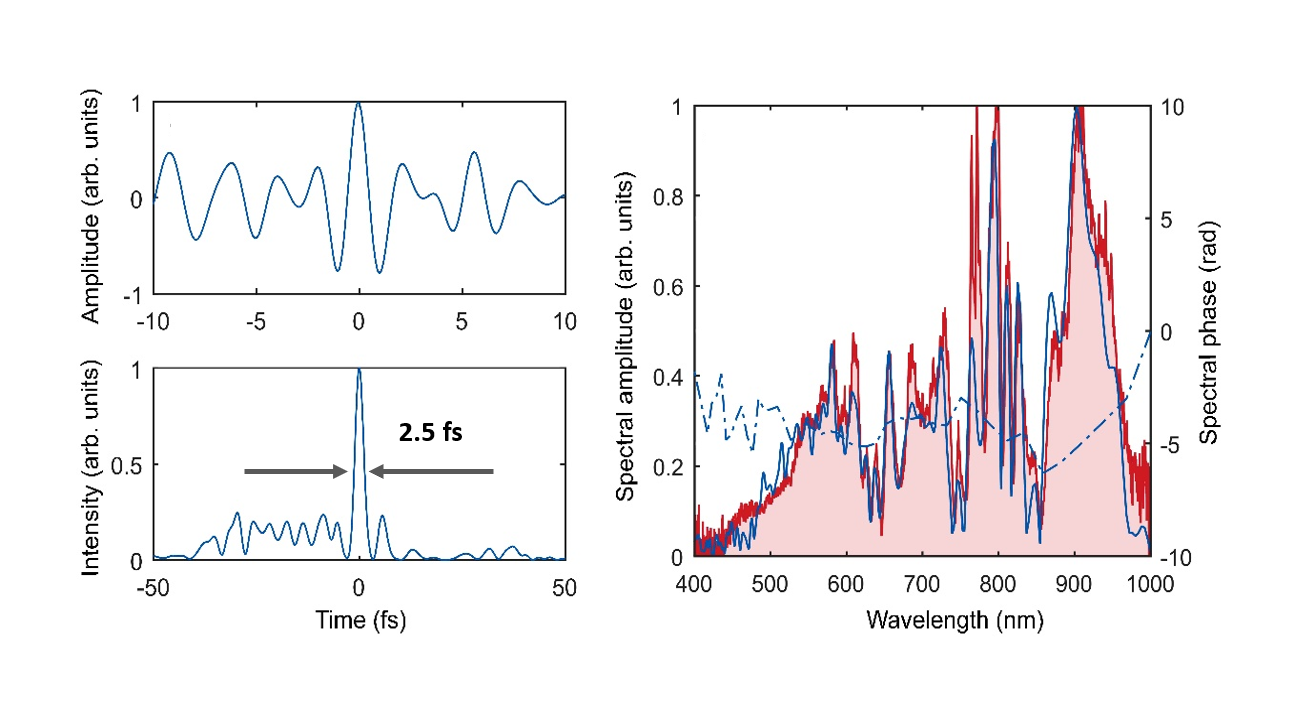BEAM SHAPING
General description of TIPTOE
TIPTOE is an acronym for Tunneling Ionization with a Perturbation for the Time-Domain Observation of an Electric field. TIPTOE is a pulse characterization technique in which the extreme nonlinearity of ionization is utilized.
An input laser pulse is split into two pulses, one strong and the other weak. The two laser pulses are focused on a target (typically, air), and ionization yield is measured as a function of time delay between the two pulses. The temporal profile of the input pulse can be found from the modulation of the ionization yield using an appropriate reconstruction algorithm.
Since the TIPTOE method utilizes the extreme nonlinearity of ionization, the technique can be applied in a broad wavelength range. According to computer simulations calculated by solving time-dependent Schrodinger equation, the TIPTOE technique can be applied for a wavelength range longer than 200 nm (and up to 20µm in practice).
The TIPTOE technique can be applied for single-cycle, few-cycle and multi-cycle pulses. The intensity of the input pulse should be high enough to ionize the target.

Tiptoe

TIPTOE is an acronym for Tunneling Ionization with a Perturbation for the Time-Domain Observation of an Electric field. TIPTOE is a pulse characterization technique in which the extreme nonlinearity of ionization is utilized.
An input laser pulse is split into two pulses, one strong and the other weak. The two laser pulses are focused on a target (typically, air), and ionization yield is measured as a function of time delay between the two pulses. The temporal profile of the input pulse can be found from the modulation of the ionization yield using an appropriate reconstruction algorithm.
Since the TIPTOE method utilizes the extreme nonlinearity of ionization, the technique can be applied in a broad wavelength range. According to computer simulations calculated by solving time-dependent Schrodinger equation, the TIPTOE technique can be applied for a wavelength range longer than 200 nm (and up to 20µm in practice).
The TIPTOE technique can be applied for single-cycle, few-cycle and multi-cycle pulses. The intensity of the input pulse should be high enough to ionize the target.
TIPTOE

TIPTOE measurement of a single-cycle laser pulse
Performances:
Developed by CoReLS lab (Korea) and SourceLAB, the SL-TIPTOE system is an advanced crosscorrelator, patented by the Institute for Basic Science (IBS – Korea), to reconstruct the short pulse electric field in the time-domain. The following datasheet lists the SL-TIPTOE specifications.
Pulse duration: 0.5 fs – 2 ps
– The lower limit (0.5 fs) is set by the wavelength range specified below .
– The upper limit is set by the travel range of the piezo. It can be changed to longer travel range on request.
Wavelength range: 200 nm – ∞
– The lower limit (200 nm) is set by the ionization energy of air molecules (O2).
– The upper limit is often set by the required pulse energy .
– Experimentally tested for 266 nm – 10 um (in W. Cho et al., Sci Rep, 2019)
Pulse energy required: Approximately 2 uJ @ 400 nm, 10 uJ @ 800 nm, and 60 uJ @ 10 um for a pulse duration up to 50 fs
– More energy is required for a longer pulse
Dispersion range: The pulse duration should be shorter than three times of the transformlimited pulse duration for an accurate measurement.
Dimensions: 146 mm (W) x 310 mm (D) x 83 mm (H)
Min. input beam height: 2.5 inch
Numerical aperture (w/o reimaging system): 5 – 10 mm
Rep rate: 10 Hz or higher recommended
Data acquisition time: 2-10 s @ 1kHz rep. rate, 10-100 s @ 10 Hz rep rate
Output file format: Text (ascii) file (raw data and reconstruction result), jpeg (screen shot)
Output file size: ~100 kbytes
Data processing time: 1 – 20 s
Computer requirements: Quad core CPU, 8 GB memory, 15 inch screen with 1920×1080 resolution (provided with the instrument)
Vacuum compatibility: On request
– Possible if an ionization gas is supplied by a gas jet or the base pressure is high enough to detect ionization (a few torr).
…
No download available.
- Daniault et al.
Sub-2-cycle post-compression of multi-mJ energy Ti:sapphire laser pulses in a gas-filled multi-pass cell
Opt.Lett. 49,6833 (2024)
- Ziyao Wang et al.
Nonlinear pulse compression to sub-two-cycle, 1.3 mJ pulses at 1.9 μm wavelength with 132 W average power
Opt.Lett. 48,2647-2650(2023)
- M. Karst et al.
22-W average power high pulse energy multipass-cell-based post-compression in the green spectral range
Opt.Lett. 48,1300-1303(2022)
- J. Blöchl et al.
Spatiotemporal sampling of near-petahertz vortex fields
Optica, 9, 7, 755-761 (2022)
- Tsai et al.
Nonlinear compression toward high-energy single-cycle pulses by cascaded focus and compression
Sci. Adv. 8, eabo1945 (2022)
- Wosik Cho, Jeong-uk Shi & Kyung Taec Kim
Reconstruction algorithm for tunneling ionization with a perturbation for the time-domain observation of an electric-field
Scientific Reports volume 11, 13014 (2021)
- M. Kurusz et al.
2.3-cycle mid-infrared pulses from hybrid thin-plate post-compression at 7 W average power
Optics Communication 472, 126035 (2020)
- K. T. Kim
Temporal Characterization of a laser pulse in the time-domain using tunneling ionnization
LPA seminar video (visit lpa-seminars.com)
- N. Saito et al.
All-optical characterization of the two-dimensional waveform and the Gouy phase of an infrared pulse based on plasma fluorescence of gasTemporal characterization of a two-color laserfield using tunneling ionization
Optic Express 26, 19,24591 (2018)
- Seung Beom Park et al.
Direct sampling of a light wave in air
Optica 5, 402-408 (2018)
- S.I. Hwang et al.
Generation of a single-cycle pulse using a two-stage compressor and its temporal characterization using a tunnelling ionization method
Scientific Report 9, 1613 (2019)
- W. Cho et al.
Temporal characterization of femtosecond laser pulses using tunneling ionization in the UV, visible, and mid-IR ranges
Scientific Report 9, 16067 (2019)
- Overview
-
General description of TIPTOE
TIPTOE is an acronym for Tunneling Ionization with a Perturbation for the Time-Domain Observation of an Electric field. TIPTOE is a pulse characterization technique in which the extreme nonlinearity of ionization is utilized.
An input laser pulse is split into two pulses, one strong and the other weak. The two laser pulses are focused on a target (typically, air), and ionization yield is measured as a function of time delay between the two pulses. The temporal profile of the input pulse can be found from the modulation of the ionization yield using an appropriate reconstruction algorithm.
Since the TIPTOE method utilizes the extreme nonlinearity of ionization, the technique can be applied in a broad wavelength range. According to computer simulations calculated by solving time-dependent Schrodinger equation, the TIPTOE technique can be applied for a wavelength range longer than 200 nm (and up to 20µm in practice).
The TIPTOE technique can be applied for single-cycle, few-cycle and multi-cycle pulses. The intensity of the input pulse should be high enough to ionize the target.

Tiptoe

TIPTOE is an acronym for Tunneling Ionization with a Perturbation for the Time-Domain Observation of an Electric field. TIPTOE is a pulse characterization technique in which the extreme nonlinearity of ionization is utilized.
An input laser pulse is split into two pulses, one strong and the other weak. The two laser pulses are focused on a target (typically, air), and ionization yield is measured as a function of time delay between the two pulses. The temporal profile of the input pulse can be found from the modulation of the ionization yield using an appropriate reconstruction algorithm.
Since the TIPTOE method utilizes the extreme nonlinearity of ionization, the technique can be applied in a broad wavelength range. According to computer simulations calculated by solving time-dependent Schrodinger equation, the TIPTOE technique can be applied for a wavelength range longer than 200 nm (and up to 20µm in practice).
The TIPTOE technique can be applied for single-cycle, few-cycle and multi-cycle pulses. The intensity of the input pulse should be high enough to ionize the target.
TIPTOE

TIPTOE measurement of a single-cycle laser pulse
- Specifications
-
Performances:
Developed by CoReLS lab (Korea) and SourceLAB, the SL-TIPTOE system is an advanced crosscorrelator, patented by the Institute for Basic Science (IBS – Korea), to reconstruct the short pulse electric field in the time-domain. The following datasheet lists the SL-TIPTOE specifications.
Pulse duration: 0.5 fs – 2 ps
– The lower limit (0.5 fs) is set by the wavelength range specified below .
– The upper limit is set by the travel range of the piezo. It can be changed to longer travel range on request.Wavelength range: 200 nm – ∞
– The lower limit (200 nm) is set by the ionization energy of air molecules (O2).
– The upper limit is often set by the required pulse energy .
– Experimentally tested for 266 nm – 10 um (in W. Cho et al., Sci Rep, 2019)Pulse energy required: Approximately 2 uJ @ 400 nm, 10 uJ @ 800 nm, and 60 uJ @ 10 um for a pulse duration up to 50 fs
– More energy is required for a longer pulseDispersion range: The pulse duration should be shorter than three times of the transformlimited pulse duration for an accurate measurement.
Dimensions: 146 mm (W) x 310 mm (D) x 83 mm (H)
Min. input beam height: 2.5 inch
Numerical aperture (w/o reimaging system): 5 – 10 mm
Rep rate: 10 Hz or higher recommended
Data acquisition time: 2-10 s @ 1kHz rep. rate, 10-100 s @ 10 Hz rep rate
Output file format: Text (ascii) file (raw data and reconstruction result), jpeg (screen shot)
Output file size: ~100 kbytes
Data processing time: 1 – 20 s
Computer requirements: Quad core CPU, 8 GB memory, 15 inch screen with 1920×1080 resolution (provided with the instrument)
Vacuum compatibility: On request
– Possible if an ionization gas is supplied by a gas jet or the base pressure is high enough to detect ionization (a few torr).…
- Downloads
-
No download available.
- Publications
-
- Daniault et al.
Sub-2-cycle post-compression of multi-mJ energy Ti:sapphire laser pulses in a gas-filled multi-pass cell
Opt.Lett. 49,6833 (2024)
- Ziyao Wang et al.
Nonlinear pulse compression to sub-two-cycle, 1.3 mJ pulses at 1.9 μm wavelength with 132 W average power
Opt.Lett. 48,2647-2650(2023)
- M. Karst et al.
22-W average power high pulse energy multipass-cell-based post-compression in the green spectral range
Opt.Lett. 48,1300-1303(2022)
- J. Blöchl et al.
Spatiotemporal sampling of near-petahertz vortex fields
Optica, 9, 7, 755-761 (2022)
- Tsai et al.
Nonlinear compression toward high-energy single-cycle pulses by cascaded focus and compression
Sci. Adv. 8, eabo1945 (2022)
- Wosik Cho, Jeong-uk Shi & Kyung Taec Kim
Reconstruction algorithm for tunneling ionization with a perturbation for the time-domain observation of an electric-field
Scientific Reports volume 11, 13014 (2021)
- M. Kurusz et al.
2.3-cycle mid-infrared pulses from hybrid thin-plate post-compression at 7 W average power
Optics Communication 472, 126035 (2020)
- K. T. Kim
Temporal Characterization of a laser pulse in the time-domain using tunneling ionnization
LPA seminar video (visit lpa-seminars.com)
- N. Saito et al.
All-optical characterization of the two-dimensional waveform and the Gouy phase of an infrared pulse based on plasma fluorescence of gasTemporal characterization of a two-color laserfield using tunneling ionization
Optic Express 26, 19,24591 (2018)
- Seung Beom Park et al.
Direct sampling of a light wave in air
Optica 5, 402-408 (2018)
- S.I. Hwang et al.
Generation of a single-cycle pulse using a two-stage compressor and its temporal characterization using a tunnelling ionization method
Scientific Report 9, 1613 (2019)
- W. Cho et al.
Temporal characterization of femtosecond laser pulses using tunneling ionization in the UV, visible, and mid-IR ranges
Scientific Report 9, 16067 (2019)
- Daniault et al.